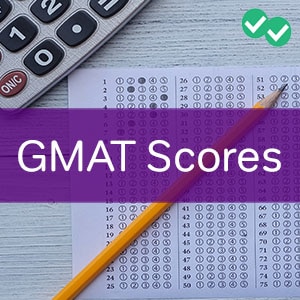
This post was updated in 2024 for the new GMAT.
The short answer? A good GMAT score is 615+ on the new GMAT and 645+ on the old GMAT. A great GMAT score is 685+ on the new GMAT and 720+ on the old.
This makes strong GMAT prep essential and worth the time and energy; good GMAT scores are essential if you want to get into a top MBA program. And a great score will make you stand out!
However, a good score is not necessarily the same for every person. In this post, we’ll cover GMAT score percentiles, good scores for top business schools, how to improve your score, and how to set your GMAT test goals.
Table of Contents
- Understanding “Good” GMAT Scores
- How the GMAT Is Scored
- What Matters in the Business School Application?
- How Long to Study?
- Tips to Improve Your Score?
- Takeaways
Understanding “Good” GMAT Scores
Why is it so crucial to get a good GMAT score on test day? The bottom line is, a great score shows admissions committees that you’re ready to take on the academic work that an MBA requires.
While your grades may be great, different schools, even different teachers, can use different grading scales and curricula. This means that a standardized test like the GMAT can be a way to level the playing field in terms of evaluating applicants. What makes GMAT scores good varies a ton according to different factors. Here are a few to take into consideration – and how you should account for them in setting your goal score.
- The program’s rankings
- Scores of recently admitted students
- The rest of your application portfolio
Top 20 programs will usually be looking for exceptional test scores. However, not ever admitted student is scoring in the 90th percentile. While test scores do carry a lot of weight, especially for top programs, admissions committees are looking at your application holistically. When you do research into the class profiles of programs you are applying to you will often see not just the average GMAT score, but also a range of scores for accepted students. You’ll want to do your best to score in the upper half of these ranges, but other factors in your application can offset lower scores. For example, demonstrating strong performance in quantitative heavy classes at the undergraduate or graduate level can make up for a lower quant score.
How the GMAT Is Scored
On the GMAT, you’ll answer questions in three sections: Verbal, Quantitative, and Data Insights. The number of questions you answered correctly in each section is then turned into a score of 60-90 in increments of 1. Finally, these scores are combined and scaled, in increments of 10, to give you your overall score on a 205-805 scale. In the new GMAT edition all sections are equally weighted in your overall score.
Each section of the exam lasts 45 minutes, but the amount of questions you’ll be asked to answer differs between all three. You’ll see 20 questions in the Data Insights section, 23 questions in the Verbal section, and 21 questions in the Quant section.
Every section is immediately graded by the computer: as soon as you are done with your DI, your Quant, or your Verbal sections, the computer already knows your score. Your unofficial scores will be provided to you as soon as you complete the exam. You’ll be able to view your total score and section scores, but not to write them down. An official score report will be made available to you within 3-5 days of finishing your test.
Computer Adaptive Testing
All three sections employ Computer Adaptive Testing (CAT). The CAT changes the difficulty, question by question, as you move through the section. As a general pattern, if you are getting questions right, the CAT gives you harder questions, and if you are struggling, the CAT will give you easier questions. CAT is trying to pinpoint a test taker’s ability level through the use of a complex algorithm in order to level the testing play field as much as possible.
That’s the overall trend, although this highly complex algorithm also does sweeps through different difficulties: for example, you may get an easy question out of the blue even if you did nothing wrong. The grading for the CAT does NOT depend on simply the number of questions you answer correctly or incorrectly: instead, the score depends on the difficulty of the questions. Therefore, the person who gets a 450 and the person who gets a 750 might have gotten about the same number of questions right and wrong, but the difficulties were in very different zones. This algorithm is highly sophisticated and virtually impossible for test takers to “crack”. Don’t make the common mistake of trying to predict, interpret, or manipulate the algorithm. Answer each question to the best of your ability and then try to forget it before moving on to the next question.
The CAT and Strategies
The computer-adaptive format of the GMAT can be intimidating at first if you haven’t taken an adaptive test before. But the more you prepare, the easier it’ll be on test day!
In short, here’s how GMAT scoring works: Correct answers x difficulty level = score. What this means for the questions you’ll see is that the difficulty adapts as you go.
In terms of your strategy, first things first: you definitely need one to get a high GMAT score! Here are a few key points to keep in mind:
- Don’t guess on a bunch of answers in a row.
- Skipping questions is generally bad.
- Develop a pacing strategy.
As you work on perfecting your pacing, here’s what to keep in mind:
- You have 2.15 minutes for each Quant question
- You have ~2 minutes for each Verbal question
- You have 2.25 minutes for each Data Insight question
With that said, different questions types will take you less or more time. Take a look at GMAT timing strategies to prepare.
What Matters in the Business School Application?
When you apply for an MBA, admissions committees look at many factors in combination. GMAC, the test-maker, polled business schools to find which factors they considered most strongly.
Chief among these? You’d be surprised—it’s not GMAT scores, though they came in a close second! It’s how you perform on your interviews.
However, not everybody gets an interview. And the way to get one? Have stellar materials. GMAT scores are one factor used to determine who gets an interview. Overall, they weight these scores nearly as much as the interview itself.
This means that in terms of approaching your applications, GMAT scores are incredibly important.
From there admissions committees consider:
- Undergraduate transcripts
- Resume
- Essays
- Letters of recommendation
- Student bio
- Short-answer questions
Out of all the factors you can still control, your GMAT scores are far and away the most important to MBA programs.
How Long to Study for the Highest GMAT Score?
The short answer is that you should plan for 2-3 months of intensive GMAT study. However, this can vary depending on other factors. Take a free GMAT Practice Test to help gauge where you are in your prep!
How Much Can I Improve My Score?
Hitting a wall when you’re trying to improve your GMAT score can be incredibly frustrating. You’re putting in the time and the effort, but your score just doesn’t seem to be going up. First of all: what’s a realistic score increase goal to set for yourself? In general, a 70-100 point improvement should be doable for most test-takers, while an increase of 100+ points is less likely—but still possible!
It can be really tricky to set down general guidelines that apply to everyone—possible increases depend on everything from how much you’ve already studied to how long ago your last math class was! But, with that said, there are definitely ways to put yourself on the bigger side of that score improvement range.
Crucially, it’s possible to draw a straight line between your final, official GMAT score and the number of hours you study. Students with top scores are likely to spend 170+ hours prepping for the GMAT. But just putting in the time alone isn’t necessarily enough to get that big score increase. You’ll need to make sure that time is invested wisely!
Tips to Improve Your Score
Pace Yourself
Preparing for the GMAT can help you raise your score, but keep in mind that there isn’t some silver bullet of a test-taking method that’s going to lead you to a top score in just a few weeks (not, at least, if your starting score is far below that level). The GMAT is built on skills as sweeping in their scope as math and reading. So if you’ve only been studying for a week or two, and you see a drop in scores of less than 50 points, don’t panic—in time, you’ll see the overall improvement you’re looking for.
Use High Quality Materials
I’ll be blunt: there’s a lot of substandard material on the market. And even if it’s a test filled with very high quality questions, mimicking GMAC’s scoring algorithm is a tricky task, since they don’t exactly release it to the public. So first, make sure you are using quality material you were using. Read reviews, look at official materials, and keep a critical eye. In general, if the test isn’t official, no matter what company it’s from (yes, including Magoosh), treat the score as an estimate. The learning experience of taking the practice test is more important than the score it provides, anyway.
Break Bad Habits
Your score decrease “problem” may actually just an indication that you’re learning. As you first go into the test, you will have certain bad habits, or, more precisely, assumptions and strategies that hold you back from your full potential. While learning more about the test and the best ways to take it, you’ll inevitably encounter skills and strategies that you wouldn’t have used on your own accord. In order to become more adept at answering certain types of questions in certain ways, you have to practice, of course. And if you spend your time and energy practicing those new, unmastered skills during a practice test (which you absolutely should) it may take away from the time and energy you could devote to the questions you’d have otherwise gotten correct.
But given more practice—and quality practice, at that—you’ll start to be able to incorporate those newly learned skills into your GMAT flow more seamlessly, which will in turn bring that higher score I know you’re looking for.
Make a Plan
If you don’t have a road map to your destination, how will you know how close you are to getting there? Having a GMAT study plan is important to direct your study, make sure you cover all content areas, and keep you on track. Not sure where to start? Check out Magoosh’s free GMAT study plans for schedules ranging anywhere from one to six months. You can also find math- and verbal-based schedules, as well as an advanced schedule if you’re starting high and aiming for a top score.
Know the Quant Fundamentals
To do well on the GMAT quant you can’t just rely on techniques such as process of elimination or approximation. At a certain point you have to know the properties of a right triangle or the difference between dependent and independent events in probability.
Of course the range of concepts tested on the GMAT is relatively vast. Wouldn’t it be great if everything from mixture problems to equations with square roots was covered in one place? Well, every math concept that can come up on the GMAT is covered in Magoosh’s lesson videos.
Get in the Habit of Reading
As is often the case, the best advice is often the simplest. If you want to improve on GMAT Verbal, then READ. Read every day: ideally, devote at least an hour a day to reading. Read hard, challenging material in English. In particular, force yourself to read what business executives have to read every day.
If you are taking the GMAT, then, implicitly, you are stating that want to spend your life in the modern business world. If you plan to spend your life in that world, shouldn’t you spend as much time learning about it as possible? Read The Financial Times every day and the Economist magazine every week. Bloomsburg Businessweek is also excellent. It can also be helpful to read the business and world politics sections of well-respected newspapers such as the New York Times.
Takeaways
The best question to ask as you start your GMAT prep is not “what’s a good GMAT score” but “what does a good GMAT score mean to me?” This will depend on your baseline score, your goals, your target programs, and other application factors. However, once you know what you’re aiming for, you’ll be able to craft a plan to get there. Picking a goal score isn’t an easy task, but it’s well worth the payoff!
If you’re ready to reach your GMAT score goals, Magoosh GMAT can help! We offer over 800 practice questions and 200 video lessons to cover everything you need to know for the GMAT. Get a year of access with Premium, or try us for free with a 1-week trial!





Leave a Reply